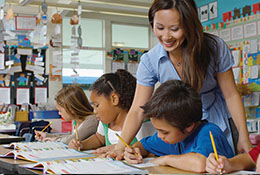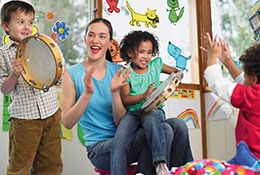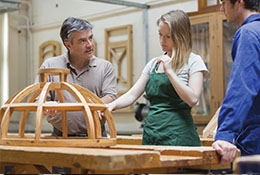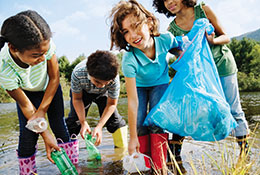SEDL INSIGHTS, Vol. 2, No. 1 (Spring 2014)
Building Supportive Relationships in Afterschool
SEDL Insights on Building Supportive Relationships in Afterschool
- Encourage positive relationships between staff and students.
- Link to the school-day staff.
- Support and train program staff.
- Engage families.
- Collaborate with community organizations.
For more than a decade, researchers have suggested that participation in afterschool programs makes a difference for students in a variety of ways.1 Numerous studies suggest that high-quality afterschool programs enhance students’ academic success in school. Afterschool programs lead to better attitudes toward school and stronger school engagement; stronger school performance, as measured by standardized test scores and grades; higher rates of school attendance; fewer behavioral problems; and lower dropout rates.2
For afterschool programs to thrive, so that they can make a difference in student lives, staff must develop supportive relationships with a variety of stakeholders. Certainly, building caring relationships with students is critical, but so is building relationships with school-day personnel, afterschool staff, and families and community members. Developing these kinds of relationships, that support and champion afterschool programs, takes time and intentional effort.
 In SEDL’s 2003–2008 National Partnership for Quality Afterschool Learning research study, we visited 53 high-functioning afterschool programs across the United States that reported student academic gains.3 We conducted rigorous observations of the programs that we identified and focused on adults and students who had built supportive relationships that helped motivate students to expand their learning and do well in school. While there is little scientifically based evidence available about the effectiveness of specific relationship-building practices,4 recent studies, literature reviews, and our own observations from SEDL’s current work with the Illinois State Board of Education’s 21st Century Community Learning Center (21st CCLC) grantees echo the importance of supportive relationships not only with students but also with key stakeholders.5
In SEDL’s 2003–2008 National Partnership for Quality Afterschool Learning research study, we visited 53 high-functioning afterschool programs across the United States that reported student academic gains.3 We conducted rigorous observations of the programs that we identified and focused on adults and students who had built supportive relationships that helped motivate students to expand their learning and do well in school. While there is little scientifically based evidence available about the effectiveness of specific relationship-building practices,4 recent studies, literature reviews, and our own observations from SEDL’s current work with the Illinois State Board of Education’s 21st Century Community Learning Center (21st CCLC) grantees echo the importance of supportive relationships not only with students but also with key stakeholders.5
In this issue of SEDL Insights we will share with you some of what we, and others, are learning about how afterschool programs are building supportive relationships with stakeholders. Afterschool leaders and staff can use these insights to develop stronger relationships with the different partners who are invested in their program. Leaders in districts, schools, and community-based organizations may also find that these insights offer guidance on how to better support afterschool programs.
 | Encourage positive relationships between staff and students. |
 Afterschool programs provide an opportunity for educators to build relationships with students in ways not possible during the school day. Afterschool staff can take advantage of the more flexible afterschool environment and spend time listening and giving students individual attention.6 Most programs SEDL has studied and currently works with create the kind of afterschool environments that lead to supportive relationships between staff and students by communicating high expectations for students; asking for their input in planning and decision-making; and offering fun, engaging activities.
Afterschool programs provide an opportunity for educators to build relationships with students in ways not possible during the school day. Afterschool staff can take advantage of the more flexible afterschool environment and spend time listening and giving students individual attention.6 Most programs SEDL has studied and currently works with create the kind of afterschool environments that lead to supportive relationships between staff and students by communicating high expectations for students; asking for their input in planning and decision-making; and offering fun, engaging activities.
Communication helps facilitate strong relationships between staff and students. Many of the afterschool programs that participated in SEDL’s study reported that they communicate high expectations to their students. More important, they reported that communicating these expectations helps them build trust with students, find common ground, resolve conflicts, reduce behavior problems, improve academic performance, and foster positive relationships with students and their families as well as school personnel.7
Program staff also can ask students to communicate their needs and interests to program staff. We observed that students, especially those in secondary, who participated in decision-making and planning activities in afterschool programs were more invested in the program and more likely to continue attending. One program we visited gave students a voice in decision-making by providing them with opportunities for leadership, planning events, determining what activities were offered, and selecting where to locate service-learning projects. Another program allowed students to select what they participated in and how to use their time by letting them choose among several activities such as reading for pleasure or doing homework. Still other programs conducted student surveys and had organized student advisory groups that met regularly to provide input about programming.
Finally, the programs we observed attracted students by offering relevant and engaging activities and not limiting skills development to academic enrichment. For example, program instructors tied content to current events and engaged students in activities using online resources, newspapers, and magazines. They also made connections to popular culture by studying trends in music, television, and movies. Field trips to community sites also engaged students and provided real-world connections to school-day learning. Students at high-quality sites often participated with their peers in planning cooperative learning for these trips, as well as follow-up activities. Some activities helped students develop conflict resolution and life skills, which promoted positive relationships with others. Group activities included performance arts like poetry, dance, drama, and choir or visual arts like craft making, painting, drawing, and sculpting. For example, one program offered an innovative art class, Fun With Junk, in which youth collaborated with peers in cooperative learning teams to create art from recyclable materials. At high-quality sites, students also had the opportunity to plan cooperative learning activities and follow-up. These projects enabled students to develop social skills and stronger self esteem, which in turn facilitated more positive relationships with their peers and afterschool staff.8
 | Link to the school-day staff. |
 The afterschool programs that participated in our study report using a variety of strategies to link to the school day. These include taking deliberate steps to build positive relationships, aligning rules and curriculum with the school day, maintaining both informal and formal communication with school staff, and hiring some staff members who worked with both the school and the afterschool program.
The afterschool programs that participated in our study report using a variety of strategies to link to the school day. These include taking deliberate steps to build positive relationships, aligning rules and curriculum with the school day, maintaining both informal and formal communication with school staff, and hiring some staff members who worked with both the school and the afterschool program.
Building respectful relationships between the school-day and afterschool staff creates a foundation that allows staff to trust each other, plan together, share a common vision, and share responsibility for student success.9 All the school-based programs and most of the community-based programs we studied create links with school-day staff by asking them for input and help with fine-tuning afterschool academic activities and for their participation in joint planning meetings and curriculum teams.10
In the afterschool programs that we observed, we noticed that afterschool staff relied on both informal and formal communication strategies to develop and strengthen relationships with school-day staff. Afterschool and school-day staff engaged in brief hallway or lunchroom discussions and exchanged notes and emails about a student’s academic progress or behavior. In some schools, informal relationship-building activities included joint celebrations, thank you notes, care bags, and appreciation days.11 More formal communication tools ranged from regularly scheduled meetings with written agendas to homework logs and planners to communicate student progress and needs among teachers, students, and families.12
We also observed how afterschool staffing decisions can facilitate relationships and communication with the school day. Some programs hired full-time site leaders who were on campus throughout the day and responsible for communicating regularly with other program leaders and school-day administrators. Many afterschool programs also hired school day teachers and paraprofessional staff to lead academic enrichment activities.
One noteworthy science program SEDL visited provides an excellent example of how connections with the school day can help students have an enriching and engaging afterschool experience. The program was designed around the district’s science curriculum, grounded in state and national science standards and supplemented with purchased science-kit materials. The result was a program that provided students with a sense of continuity between their school-day science instruction and expanded-learning science enrichment. School-day activities focused on vocabulary, subject comprehension, and related cognitive goals while afterschool activities focused on hands-on projects that enabled students to use basic scientific principles, test hypotheses, and conduct experiments.13 This level of collaboration depends on building relationships based on trust and communication.
 | Support and train program staff. |
 Staff in high-quality programs consistently report to us that their program leaders collaborate rather than dictate, are respectful of staff ideas, and support staff efforts. Staff across all positions say that the program directors’ collaborative and supportive behaviors—even more than monetary rewards—contribute to their willingness to continue working in the program, which in turn supports positive relationships with other stakeholders. Staff who stay with the program over time are able to provide the continuity necessary to build and maintain supportive relationships with students.14
Staff in high-quality programs consistently report to us that their program leaders collaborate rather than dictate, are respectful of staff ideas, and support staff efforts. Staff across all positions say that the program directors’ collaborative and supportive behaviors—even more than monetary rewards—contribute to their willingness to continue working in the program, which in turn supports positive relationships with other stakeholders. Staff who stay with the program over time are able to provide the continuity necessary to build and maintain supportive relationships with students.14
We have also seen that providing meaningful professional development for afterschool staff can facilitate stronger relationships among afterschool leaders and their teams. Afterschool staff say they want professional development that boosts their confidence and ability to build positive relationships with a variety of stakeholders, especially students. Budgets and part-time employees’ availability for professional development present challenges for most programs in offering staff professional development; however, we have seen industrious afterschool leaders find ways to overcome these challenges. Some programs provide professional development in 15-minute segments each week during staff meetings, while others offer individual coaching sessions. The leadership team at one afterschool program that we visited provided professional development and orientation for both new and returning staff at a meeting held at the beginning of the school year. This meeting covered the goals and expectations of the program’s grant; workshops on core content areas, curriculum goals, and lesson plans; and alignment of activities with state standards. As the school year progressed, site coordinators continued offering short professional development sessions to their respective staff using the lesson plans and instructional videos from SEDL’s online Afterschool Training Toolkit. At leadership meetings, site coordinators reported on how staff used the toolkit and shared challenges and successes with their colleagues. These short but frequent professional development sessions provided learning opportunities that fit the program’s schedule and budget and also helped afterschool instructors develop their skills and stronger relationships with students.
 | Engage families. |
 Frequent and positive communication with family members is critical to building supportive relationships with students’ families and effectively engaging them in their child’s education.15 This means treating family members with respect, asking them about their own lives and interests, and ensuring that interactions with family members don’t just happen when there is a problem with a student. We have learned through the National Partnership for Quality Afterschool Learning study and our current work with Illinois 21st CCLC programs that engaging families involves more than getting them to show up for afterschool events. High-quality programs use a variety of strategies to leverage family engagement in ways that build capacity of family members to support students’ education.
Frequent and positive communication with family members is critical to building supportive relationships with students’ families and effectively engaging them in their child’s education.15 This means treating family members with respect, asking them about their own lives and interests, and ensuring that interactions with family members don’t just happen when there is a problem with a student. We have learned through the National Partnership for Quality Afterschool Learning study and our current work with Illinois 21st CCLC programs that engaging families involves more than getting them to show up for afterschool events. High-quality programs use a variety of strategies to leverage family engagement in ways that build capacity of family members to support students’ education.
We have observed programs that support families’ needs by asking the families themselves what services and information they want or need. Many programs used surveys—and even informal conversations—to get input from family members. Some programs also organized family advisory committees that provided input for program plans. We have also observed afterschool programs that built interaction and supportive relationships with students’ families by encouraging them to volunteer on site. These volunteer opportunities included providing classroom support or expertise in an area and chaperoning at events and on field trips. Inviting families to participate contributed to a sense of self worth and empowers families to become part of the afterschool program community.
In addition to offering engaging activities for students, high-quality programs offer classes for family members. These activities can include evening and weekend classes on crafts, cooking, English as a second language, and preparing for the General Educational Development (GED) exam. Some programs, mainly in large urban areas, share and use school-based family centers that are available during both the school day and the afterschool program time.
Just as they do with other stakeholders, high-quality afterschool programs maintain frequent communication—both formal and informal—with students’ families. Formal communication includes newsletters; program orientation; family nights; home visits; and letters, notes, and phone calls about student progress. Informal communications we observed include regular and frequent family chats when parents pick up their students.
We have also seen afterschool programs that take special measures to make family members feel welcome and comfortable at the afterschool program site.16 Some create a welcoming program space with open doors and helpful signs in families’ native languages to help them feel at home at the afterschool programs. Others have also created a “family corner” in which family members can find resources about the program and community services.
Finally, effective strategies for building staff–family relationships include hiring staff who reflect the demographics of the families served and training staff to respect cultural differences, including how to examine their own biases. Once staff are hired, effective programs provide ongoing training and support to staff to ensure that building family relationships and engagement are part of their daily activities. Some programs set aside time at staff meetings to reflect on and improve their family engagement relationships.17
 | Collaborate with community organizations. |
 Building a broad base of community relationships can provide students with opportunities to explore new interests, identify role models, and become immersed in their community.18 These partnerships can also help increase the sustainability of afterschool programs over time.19 One strategy for building these relationships is to create opportunities to engage community members in activities, committees, and events that support the program.
Building a broad base of community relationships can provide students with opportunities to explore new interests, identify role models, and become immersed in their community.18 These partnerships can also help increase the sustainability of afterschool programs over time.19 One strategy for building these relationships is to create opportunities to engage community members in activities, committees, and events that support the program.
Virtually every program we visited, regardless of location and community size, used relationships with a variety of local individuals, groups, and organizations to provide expertise, knowledge, and additional learning opportunities for students. For example, afterschool programs with an arts focus have created connections with cultural centers and conducted field trips to art exhibits. Science and technology programs favored field trips that supplemented the science and technology curriculum. One science program sponsored a trip to a multinational aerospace manufacturer and to an advanced technology company. Programs in smaller rural areas visited local resources and businesses such as agriculture companies to support learning.
A large number of programs and sites we studied built community relationships and support by organizing mentoring and tutoring programs that used individuals or groups such as local service clubs, businesses, politicians, high school and college students, Boy and Girl Scouts, Boys & Girls Clubs of America, and faith-based organizations to provide both academic and recreational support for students. Community mentors and tutors offer students a variety of role models and enriching relationships and learning experiences. At the same time, community members report that their relationships with students are positive and increase their willingness to support afterschool programs in their communities.
Afterschool programs that contribute time and effort to “give back” to the school and community to meet mutual goals report much stronger levels of support than programs where their community involvement is focused only on what community organizations can do for them. We observed students participating in a range of service-learning projects, such as designing get-well cards for and making visits to nursing home residents; tutoring younger students; and participating in recycling activities, community beautification projects, community gardens, and ecosystem projects. Staff indicated that the number and range of individuals and groups, including elected officials, who provide overall afterschool program support increases when the program has ongoing relationships with those individuals and groups and students participate in service-learning projects with them.20 All of these service-related activities contribute to the program’s ability to sustain itself and create supportive relationships needed to foster an understanding of local community needs.
Conclusion
 Building supportive relationships in afterschool programs matters. When afterschool staff help students build relationships with caring adults, these ties shape their performance in school and in life. To thrive, grow, and sustain themselves, afterschool programs must build supportive relationships with program and school staff and families and community members so they can make a difference for students.
Building supportive relationships in afterschool programs matters. When afterschool staff help students build relationships with caring adults, these ties shape their performance in school and in life. To thrive, grow, and sustain themselves, afterschool programs must build supportive relationships with program and school staff and families and community members so they can make a difference for students.
How SEDL Can Help
The insights described above are based on the findings from the National Partnership for Quality Afterschool Learning’s study of promising 21st CCLC afterschool programs across the United States and our work with the Illinois State Board of Education’s 21st CCLC grantees in Illinois.
SEDL offers a suite of professional development and evaluation services as well as free resources for educators who are interested in improving their afterschool programs. We encourage you to explore the following resources:
- What Works? Common Practices in High Functioning Afterschool Programs: The National Partnership for Quality Afterschool Learning Final Report
- A Practitioner's Guide: Building and Managing Quality Afterschool Programs
- The Afterschool Training Toolkit professional development resources
- Illinois Quality Afterschool project
- National Center for Quality Afterschool
Footnotes
1 Little, 2011; Lauver, 2012; Palmer, Anderson, & Sabetelli, 2009.
2 Afterschool Alliance, 2008.
3 The National Partnership for Quality Afterschool Learning’s final report provides a summary of the findings on promising afterschool programs. See Huang, Cho, Mostafavi, & Nam, 2008.
4 For more details see the Introduction in A Practitioner’s Guide: Building and Managing Quality Afterschool Programs. See Jordan, Parker, Donnelly, & Rudo, 2009.
5 Pompa, 2013; Birmingham, Pechman, Russell, & Mielke, 2005; Szekely & Clapp Padgette, 2006.
6 Little, Wimer, & Weiss, 2008.
7 Huang et al., 2008.
8 Huang et al., 2008.
9 Young, 2011.
10 Huang et al., 2008.
11 Birmingham, et al., 2005.
12 Huang et al., 2008.
13 Jordan et al., 2009.
14 Huang et al., 2008.
15 Jordan et al., 2009.
16 Mapp, 2007.
17 Little, 2013.
18 Huang et al., 2008.
19 Szekely & Clapp Padgette, 2006.
20 Huang et al., 2008.
References
Afterschool Alliance. (2008, February). Afterschool fosters success in school. Issue Brief, No. 31. Washington, DC: Author. Retrieved from http://www.afterschoolalliance.org/issue_31_sch_success.cfm
Birmingham, J., Pechman, E. M., Russell, C. A., & Mielke, M. (2005). Shared features of high performing after-school programs: A follow-up to the TASC evaluation. Washington, DC: Policy Studies Associates.
Bouffard, S., Westmoreland, H., O’Carroll, K., & Little, P. (2011). Engaging families in out-of-school time programs. In H. Kreider & H. Westmoreland (Eds.), Promising practices for engaging families in out-of-school time (pp. 3–19). Charlotte, NC: Information Age.
Huang, D., Cho, J., Mostafavi, S., & Nam, H. (2008). What works? Common practices in high functioning afterschool programs: The National Partnership for Quality Afterschool Learning final report. Austin, TX: SEDL. Retrieved from http://www.sedl.org/pubs/catalog/items/family124.html
Iowa School Boards Foundation. (2007, August). Family school community connections: Improving student learning. Information Briefing 1(6). Retrieved from http://www.ia-sb.org/assets/6822accf01e64833a1a3f99b1fddd217.pdf
Jordan, C., Parker, J., Donnelly, D., & Rudo, Z. (2009). A practitioner’s guide: Building and managing quality afterschool programs. Austin, TX: SEDL.
Lauver, S. (2012, March) Supporting student success through after-school and expanded learning programs.District Administration, 48(3), 40–43.
Little, P. (2011). Family engagement needs inventory. San Antonio, TX: Edvance Research.
Little, P. (2013). Evidence-based strategies for supporting and enhancing family engagement. In T. K. Peterson, (Ed.), Expanding minds and opportunities: Leveraging the power of afterschool and summer learning for student success (pp. 330–334). Washington, DC: Collaborative Communications Group. Retrieved from http://expandinglearning.org/expandingminds/article/evidence-based-strategies-supporting-and-enhancing-family-engagement#sthash.0o6kHWpv.dpf
Little, P., Wimer, C., & Weiss, H. B. (2008, February). After school programs in the 21st century: Their potential and what it takes to achieve it. Issues and Opportunities in Out-of-School Time Evaluation Brief, No. 10. Cambridge, MA: Harvard Family Research Project.
Mapp, K. L. (2007, June 13). The why, what and how of effective school, family and community partnerships. Paper presented at the meeting of the Iowa Statewide Parent Information Resource Center Board of Directors.
Northwest Regional Educational Laboratory (2003). Evaluating supplemental educational service providers: Issues and challenges. Portland, OR: Author.
Palmer, K .L., Anderson, S. A., & Sabatelli, R. M. (2009, Fall). How is the afterschool field defining program quality?: A review of effective program practices and definitions of program quality. Afterschool Matters, 8, 1–12. Retrieved from http://www.niost.org/Afterschool-Matters/afterschool-matters-fall-2009
Pompa, D. (2013). Family involvement as a critical element of quality expanded learning opportunities. In T. K. Peterson, (Ed.), Expanding minds and opportunities: Leveraging the power of afterschool and summer learning for student success (pp. 325–329). Washington, DC: Collaborative Communications Group.
Szekely, A., & Clapp Padgette, H. (2006). Sustaining 21st Century Community Learning Centers: What works for programs and how policymakers can help. Washington, DC: The Finance Project.
Young, P. G. (2011, November). Relationships among leaders key to aligning the learning day. School-Age NOTES, 32(3), 3–6.
About SEDL Insights
SEDL Insights is based on the experience, expertise, and research of SEDL staff. It is designed to give education practitioners practical suggestions for implementing school improvement strategies.
About SEDL
SEDL is a nonprofit education research, development, and dissemination organization based in Austin, Texas. Improving teaching and learning has been at the heart of our work throughout our near 50 years of service. SEDL partners with educators, administrators, parents, and policymakers to conduct research and development projects that result in strategies and resources to improve teaching and learning. SEDL also helps partners and clients bridge the gap between research and practice with professional development, technical assistance, and information services tailored to meet their needs.
All photos are copyright Thinkstock.
You are welcome to reproduce issues of SEDL Insights and distribute
copies at no cost to recipients. Please credit SEDL as publisher.
Author: Catherine Jordan, MA
Editor: Laura Shankland, MA, PMP
Designer: Shaila Abdullah

